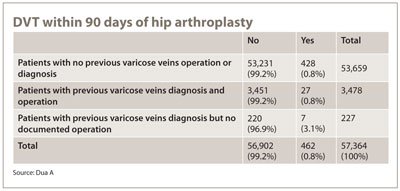No greater risk of PE for untreated varicose veins prior to either THA or TKA
Investigators found that untreated varicose veins put patients at greater risk for DVT after THA.
SAN FRANCISCO — Researchers have found increased rates of deep vein thrombosis within 90 days of total hip arthroplasty among patients with untreated varicose veins.
“Overall, patients should consider having their varicose veins treated prior to undergoing total hip arthroplasty in an attempt to reduce [deep vein thrombosis] DVT,” Anahita Dua, MD, of Brookfield, Wisc., said at the American Academy of Orthopaedic Surgeons 2012 Annual Meeting, here.
However, Dua and colleagues did not find a connection between DVT risk and untreated varicose veins for patients undergoing total knee arthroplasty (TKA). They also found no link between untreated varicose veins and pulmonary embolism (PE) risk with either TKA or total hip arthroplasty (THA).
Databases studied
|
|
A paucity of data in this area and a single study in the Romanian literature that described removal of varicose veins as being associated with decreased postoperative DVT rates for TKA, inspired Dua and her Scottish colleagues to study this topic in more depth.
“Every textbook from medical school all the way up states that varicose veins are a risk factor for DVT, but it has never been quantified,” Dua told Orthopedics Today. “No one tells you how much of a risk factor and, if it is a risk factor, then why are we not doing something about it? It is such an easy thing to take care of.”
Dua and colleagues examined records in the Scottish Arthroplasty Register to identify 57,367 patients who underwent THA and 51,859 patients who underwent TKA between 1989 and 2009. They then searched for corresponding DVT and PE events in the same study population using the Scottish Morbidity Database. In addition, they identified records of a varicose vein diagnosis and treatment in the THA and TKA populations.
The researchers used a clinical, etiologic, anatomic and pathophysiologic (CEAP) classification score of >2 as the cut off for a positive varicose vein diagnosis, Dua said at the meeting.

DVT rates
Among the THA group, investigators found that DVT rates were both 0.8% for patients with no history of varicose veins and for those diagnosed with the condition who underwent surgery for the veins.
However, patients who had a varicose vein diagnosis and no documented operation for this prior to the joint reconstruction procedure had a 3.1% rate of DVT — a difference that was statistically significant.
“Untreated varicose veins are associated with increased rates of DVT in patients with THA,” Dua, a general surgery resident at the Medical College of Wisconsin, said in her presentation.
Dua and her colleagues did not observe any greater PE rates within 90 days following THA with untreated varicose veins. The 53,659 patients studied who had no previous varicose vein diagnosis or varicose vein surgeries had a 0.7% PE rate within 90 days of undergoing THA. This was the same rate observed among the 3,478 THA patients with a previous diagnosis and surgery for varicose veins.
In comparison, the PE rate was 0.4% for the 227 patients who had a varicose vein diagnosis and no varicose vein surgery prior to undergoing THA.
The researchers also found no relationship between the incidence and treatment of varicose veins and the risk of thromboembolic events 90 days following TKA.
The study limitations, Dua said at the meeting, included short follow-up and the fact that researchers were unable to determine whether varicose veins recurred in those patients who underwent an intervention for them.
Dua told Orthopedics Today that the data do not provide answers regarding when varicose vein interventions should be completed rather that varicose veins should be considered when determining which factors can decrease a patient’s DVT risk postoperatively.
“For that you need further randomized trials, and they need to be done in a controlled fashion. They need to include every patient undergoing a systematic, similar anticoagulation profile [with the] variables controlled. Everyone gets an ultrasound. You have to … define what a DVT is and what a varicose vein is defined as in your study. That is the basis of future research work, but you can at least justify doing that study now that you have this one to say there is evidence that managing varicose veins prior to THA could, in fact, reduce DVT.” – by Susan M. Rapp
References:For more information:
- Dua A, Nieva SS, Sutherland AG. Is previous varicose vein surgery associated with deep vein thrombosis within 90 days of hip and knee replacement? Paper #32. Presented at the American Academy of Orthopaedic Surgeons 2012 Annual Meeting. Feb. 7-11. San Francisco.
- Ruxanda A, Grecu D, Surlin V, et al. [Lower limb varicosity in patients, with indication for total knee arthroplasty]. Chirurgia (Bucur). 2005; 100(3):251-254.
- Anahita Dua, MD, can be reached at Medical College of Wisconsin, 8701 Watertown Plank Rd., Milwaukee, WI 53226; 262-565-8247; email: andua@mcw.edu.
- Disclosure: Dua has no relevant financial disclosures.


